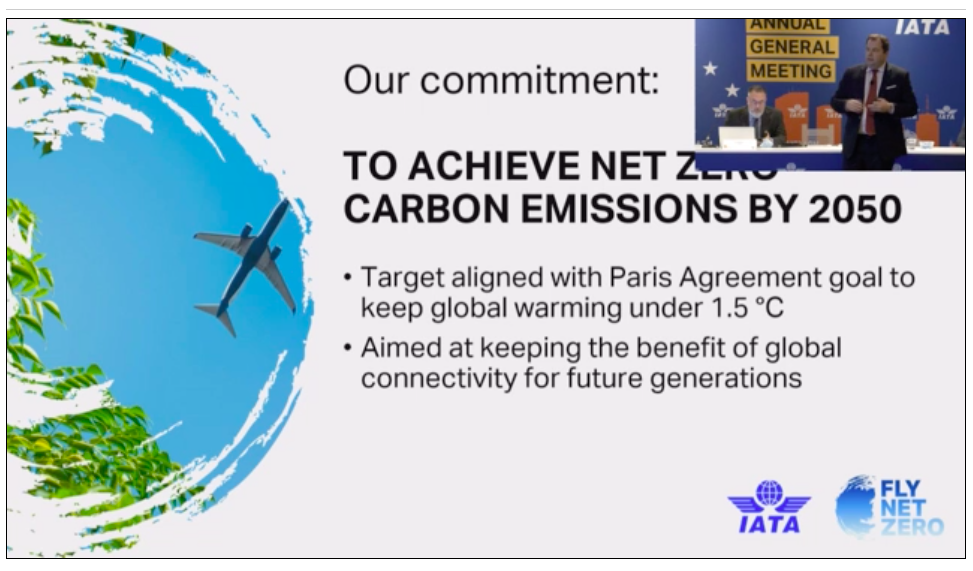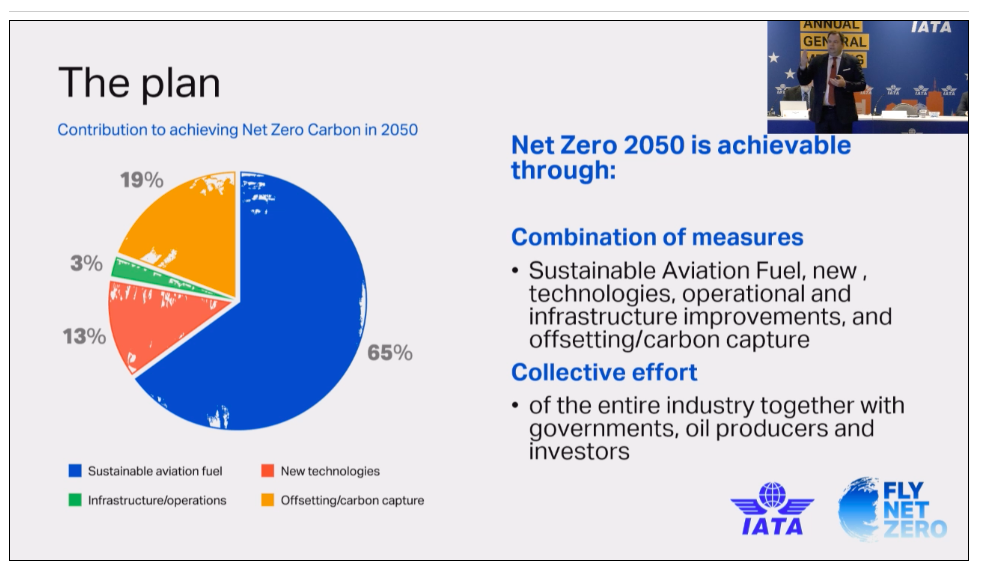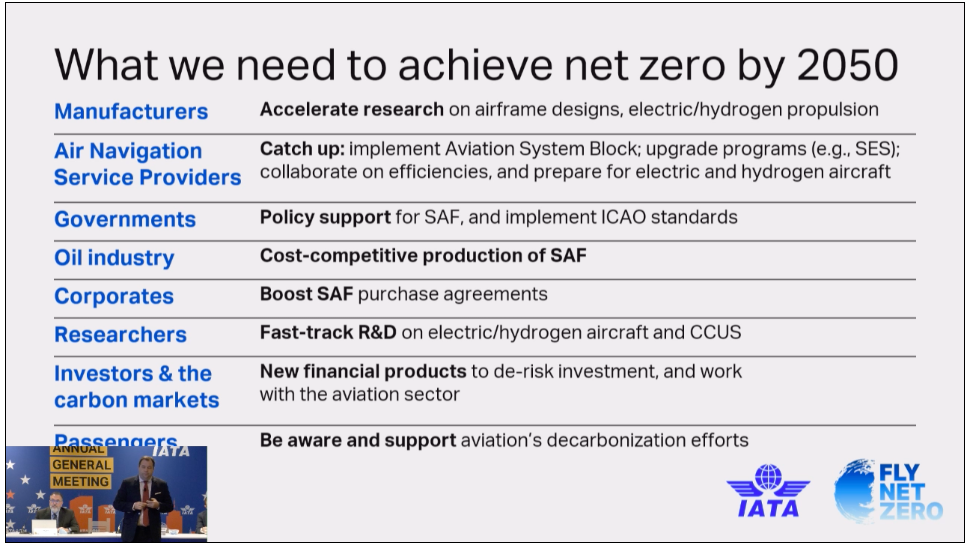One of the issues that is gaining much discussion, at least in 2021, is for aviation to become more sustainable. In September 2021, Airbus held the Airbus Summit, where they had many talks and reiterated their commitment to making a Hydrogen-powered aircraft enter service in the coming years.
On these lines, the International Air Travel Association, the airline association with most airlines as members, met in Boston this week for its 77th Annual General Meeting. One of their resolutions was to resolve that the global air transport industry will achieve net-zero carbon emissions by 2050. This commitment will align with the Paris Agreement goal for global warming not to exceed 1.5°C. You can read the full resolution here.

Willie Walsh, IATA’s Director General, on this occasion said,
The world’s airlines have taken a momentous decision to ensure that flying is sustainable. The post-COVID-19 re-connect will be on a clear path towards net zero. That will ensure the freedom of future generations to sustainably explore, learn, trade, build markets, appreciate cultures and connect with people the world over. With the collective efforts of the entire value chain and supportive government policies, aviation will achieve net-zero emissions by 2050.
Achieving net-zero emissions will be a huge challenge. The aviation industry must progressively reduce its emissions while accommodating the growing demand of a world eager to fly. To serve the needs of the ten billion people expected to fly in 2050, at least 1.8 gigatons of carbon must be abated in that year. Moreover, the net-zero commitment implies that a cumulative total of 21.2 gigatons of carbon will be diminished between now and 2050.

The International Civil Aviation Organization’s Carbon Offsetting and Reduction Scheme for International Aviation (CORSIA) is a key immediate enabler. This will stabilize international emissions at 2019 levels in the short-to-medium term. Support for this was reaffirmed in IATA’s resolution.
Willie Walsh points out the role that the entire ecosystem will have to play in this, rather than just airlines.
Achieving sustainable global connectivity cannot be accomplished on the backs of airlines alone. All parts of the aviation industry must work together within a supportive government policy framework to deliver the massive changes that are needed, including an energy transition. That is no different than what we are seeing in other industries. Road transport sustainability efforts, for example, are not being advanced by drivers building electric vehicles. Governments are providing policies and financial incentives for infrastructure providers, manufacturers and car owners to be able to collectively make the changes needed for a sustainable future. The same should apply to aviation.
The IATA states that their strategy is to abate as much CO2 as possible from in-sector solutions such as sustainable aviation fuels, new aircraft technology, more efficient operations and infrastructure, and the development of new zero-emissions energy sources such as electric and hydrogen power. Any emissions that cannot be eliminated at the source will be eliminated through out-of-sector options such as carbon capture and storage and credible offsetting schemes.
The scale of the industry in 2050 will require the mitigation of 1.8 gigatons of carbon. A potential scenario is that 65% of this will be abated through sustainable aviation fuels. Expect new propulsion technology, such as hydrogen, to take care of another 13%. And efficiency improvements will account for a further 3%. The remainder could be dealt with through carbon capture and storage (11%) and offsets (8%). The actual split, and the trajectory to get there, will depend on what solutions are the most cost-effective at any particular time. Whatever the ultimate path to net-zero will be, it is absolutely true that the only way to get there will be with the value chain and governments playing their role, said Walsh.


The resolution demands that all industry stakeholders committed to addressing the environmental impact of their policies, products, and activities with concrete actions and clear timelines, including:
- Fuel-producing companies bringing large scale, cost-competitive sustainable aviation fuels (SAF) to the market.
- Governments and air navigation service providers (ANSPs) eliminating inefficiencies in air traffic management and airspace infrastructure.
- Aircraft and engine manufacturers producing radically more efficient airframe and propulsion technologies; and
- Airport operators providing the needed infrastructure to supply SAF, at cost, and in a cost-effective manner.
Milestones
The combination of measures needed to achieve net-zero emissions for aviation by 2050 will evolve over the course of the commitment based on the most cost-efficient technology available at any particular point in time. A base case scenario as follows is the current focus:
- 2025: With appropriate government policy support, SAF production is expected to reach 7.9 billion litres (2% of total fuel requirement)
- 2030: SAF production is 23 billion litres (5.2% of total fuel requirement). ANSPs have fully implemented the ICAO Aviation System Block Upgrades and regional programs such as the Single European Sky.
- 2035: SAF production is 91 billion litres (17% of total fuel requirement). Electric and/or hydrogen aircraft for the regional market (50-100 seats, 30-90 min flights) become available.
- 2040: SAF production is 229 billion litres (39% of total fuel requirement). Hydrogen aircraft for the short-haul market (100-150 seats, 45-120 min flights) become available.
- 2045: SAF production is 346 billion litres (54% of total fuel requirement).
- 2050: SAF production hits 449 billion litres (65% of total fuel requirement).
Analysis
The plan overly depends on Sustainable Aviation Fuel, which is currently supplied for less than 1% of the required supply globally and is more complicated, I believe, purely because it depends on feedstock which needs to be recycled, etc., it does not go much further thanI’dahaveI’dkedeI’dked to see a more broad-based approach where the industry would take more risk as well in terms of more R&D to develop more machines that fly that depend on clean fuels.
Bottomline
The commercial airline association, IATA, met this week earlier and is committing to a net-zero path for emissions by 2050, which is when the Paris Agreement aligns it to be. However, they are almost fully going in on this path hoping there will be an increased supply of Sustainable Aviation Fuel around the globe.
What do you think of IATA’s intent to net-zero emissions from aviation by 2050 and the roadmap it puts out?
Liked our articles and our efforts? Please pay an amount you are comfortable with; an amount you believe is the fair price for the content you have consumed. Please enter an amount in the box below and click on the button to pay; you can use Netbanking, Debit/Credit Cards, UPI, QR codes, or any Wallet to pay. Every contribution helps cover the cost of the content generated for your benefit.
(Important: to receive confirmation and details of your transaction, please enter a valid email address in the pop-up form that will appear after you click the ‘‘Pay Now” button for international transactions, use Paypal to process the transaction.)
We are not putting our articles behind any paywall where you are asked to pay before you read an article. We are asking you to pay after you have read the article if you are satisfied with the quality and our efforts.


Leave a Reply